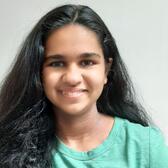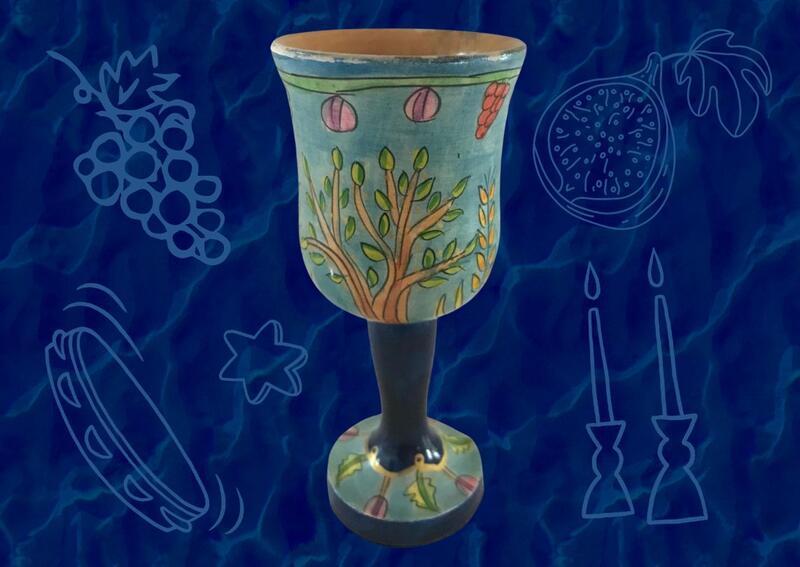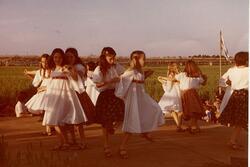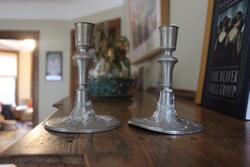How My Kiddush Cup Inspired Me to Celebrate
As the sun sets outside, I balance the large bottle of grape juice against the rim of my Kiddush cup, watching the royal purple liquid flow into the cup. The light wooden color of the inside stands out from the juice and the cup’s ornate outside, where brightly colored grapes and figs hang from a vine above date trees, wheat, and barley against a light blue sky. The paint has already faded a little near the top, where I drink from every week. Ever since I got the cup for my Bat Mitzvah, it has become a symbol of celebration, an important part of Shabbat in our house, and it has inspired me to celebrate with my family more often.
I have always loved traditions and celebrations. I love getting to do something special, something out of the ordinary, to mark an occasion. For instance, as long as I can remember, my grandmother has been lighting the Shabbat candles every week, and I have always loved joining in. Even when we aren’t together in person, almost every Friday night, my parents and I will FaceTime my grandparents and watch as my grandmother lights the candles. The tradition brings us together and gives us a chance to relax after a busy week and spend some time together. It’s always something to look forward to, and I wanted to add to it, to make it even more special. Getting my Kiddush cup was an opportunity to do so.
When my mom was growing up, my great-grandfather was the one that used to make Kiddush. Like me, I’ve been told, he loved to celebrate and he liked to mark all occasions: birthdays and anniversaries, holidays, and Shabbat. He loved family and loved bringing people together to celebrate. Shabbat was a regular chance to do this. My mom and grandparents would go to my great-grandparents’ house and my great-grandmother would cook a special meal with traditional Ashkenazi Jewish foods. Then, as the eldest and most respected man in the house, my great-grandfather would make Kiddush.
I grew up hearing stories about my great-grandfather and how he used to make Kiddush, but most Friday nights, we only lit candles. Only later, as I began to prepare for my Bat Mitzvah did my mom start to make Kiddush a little more often to make sure I knew how. After my Bat Mitzvah, I decided to preserve the weekly tradition of Kiddush on our family Shabbats using my new Kiddush cup. Even though Kiddush has traditionally been done by men and I was just a girl, I took it upon myself to make Kiddush, trying to follow in my great-grandfather’s footsteps.
My Kiddush cup continues to inspire me to follow traditions. A couple years after I started doing Kiddush on Friday nights, I suggested that my family also start doing Havdalah on Saturday nights. I had done Havdalah at my synagogue a few times but it was somewhat new in my family, because unlike our Friday night rituals, Havdalah had never really been something that my family did at home. I even had to watch a few YouTube videos to learn the tunes for the blessings. The melodies were beautiful and I was really excited to be able to sing them with my family. Although we are not religious, my family usually likes to recite songs and blessings according to the Ashkenazi Jewish tradition since this is the way my great-grandfather used to do it when my mom was growing up. These are the same melodies that he learned from his family while growing up in a Jewish community in Lithuania. Yet when it came to the Havdalah songs, I decided to add a modern twist.
Some Havdalah tunes my family did already know well, as they had grown up singing songs such as “Eliyahu HaNavi” (Elijah the prophet). For me, though, it was important not only to include “Eliyahu HaNavi” but also to include “Miriam HaNeviah” (Miriam the prophet), a song to the same tune with lyrics about Miriam instead of Elijah. So many Jewish songs and stories only focus on our male ancestors, but I think it’s really important to remember the women in our history and the important contributions they made. Often remembered as Moses’ sister, Miriam was a leader in her own right. She was the one that saved her brother and made sure he was protected as he grew up. However, when we remember Miriam, it’s not only for this, but also for the way she celebrated, leading the Israelites in song and dance, after they escaped from Egypt and crossed the Red Sea. She is an inspiration to me in my own effort to lead my family in celebration.
Shabbat with my family is just the beginning. Looking forward, I hope to continue to take inspiration from Miriam in everything I do. I hope to bring joy to my family and community as she did. I hope to spend time celebrating more of my traditions. While I never got to meet my great-grandfather, these rituals link me to him. In a way, they provide a shared experience, a tie across time through the making of Kiddush. My Kiddush cup represents all of this. It is a symbol of my connection with my ancestors, family, history, and identity.
This piece was written as part of JWA’s Rising Voices Fellowship.








Thank you.
My wife and loved it, it’s so inspiring and touching .
A good example for all young people .
Nice writing and nice tradition .